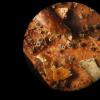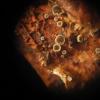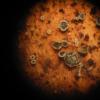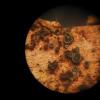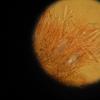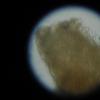
21-04-2018 11:59
Me mandan el material seco desde GaliciaEn nido de

05-02-2013 14:00
David KellyHello,I found this small orange Ascomycete in a fo

22-04-2018 18:46
Thorben HülsewigHi there,yesterday i found on leaves of Nolina lon

22-04-2018 12:54
Me mandan el material seco desde GaliciaEn rama de

20-04-2018 23:13
Can anyone tell me which genus this cup might be.

21-04-2018 19:02
Juuso ÄikäsFound these a few days ago growing on a well-rotte

21-04-2018 11:00
 Lefèvre Lefèvre
Lefèvre Lefèvre
Trouvé en Province de Namur ( Belgique ) sur morc
Bois rougi
Michel RIMBAUD,
23-04-2018 12:06
Hier j'ai récolté ces petits disco sur feuillu décortiqué (peut-être Salix). C'est le bois rougi qui a attiré mon attention, j'ai pensé que ce serait un bon critère pour la détermination, mais je n'ai rien trouvé.
Fructifications de forme conique, diam 0,5 mm, marge festonnée en viellissant.
Extérieur gris, furfuracée de brun-jaunâtre. Hymenium brun olivacé.
Asques J- (Melzer), pas de croziers, 4,8 x 37µ.
Spores ovoïdes lisses, non septées, env. 1,6 x 4,5µ.
Quelqu'un a-t-il une piste de recherche à me suggérer ?
Michel.
Hans-Otto Baral,
23-04-2018 12:28

Re : Bois rougi
Yes, this is a Hyphodiscus, probably H. hymeniophilus. The asci should have a minute amyloid apical ring, but in Melzer the reaction can easily be suppressed, it is hemiamyloid, so either you must pretreat for some seconds in KOH and then test MLZ (after washing), or test IKI (Lugol).
the fungus has a conidial state (Phialophora-like: Catenulifera rhodogena) which also causes the red stain. The connection is proved, but Index F. does not show the connection.
the fungus has a conidial state (Phialophora-like: Catenulifera rhodogena) which also causes the red stain. The connection is proved, but Index F. does not show the connection.
Lothar Krieglsteiner,
23-04-2018 12:30

Re : Bois rougi
Hello Michel,
a track could perhaps be Hyphodiscus hymeniophilus
Best regards, Lothar
Michel RIMBAUD,
23-04-2018 16:07
Re : Bois rougi
Yes, great !
Thank you very much Zotto and Lothar.
Michel
Thank you very much Zotto and Lothar.
Michel

